Taking a dip in your swimming pool with your family is more enjoyable if there are no swimming bugs in the pool. Most of these so-called pool bugs can be nuisances, and small children should not go near them. But then, some of them are considered beneficial because they provide balance in the ecosystem.
What are the types of swimming pool bugs that bite and the ones that don’t bite? The types of swimming pool bugs that bite are backswimmers, giant water bugs, and predaceous diving beetles. On the other hand, the non-biting water bugs in pools include water striders, water boatmen, and water mites.
Some of these bugs in swimming pools are look-alikes and have some similar behaviors. Looking at pool bugs pictures alone may confuse you.
This is why you should know how to identify them correctly before taking any action. In this guide, you will learn everything about pool bugs and how to get rid of them.
Swimming Pool Bugs That Don’t Bite
1. Water Striders
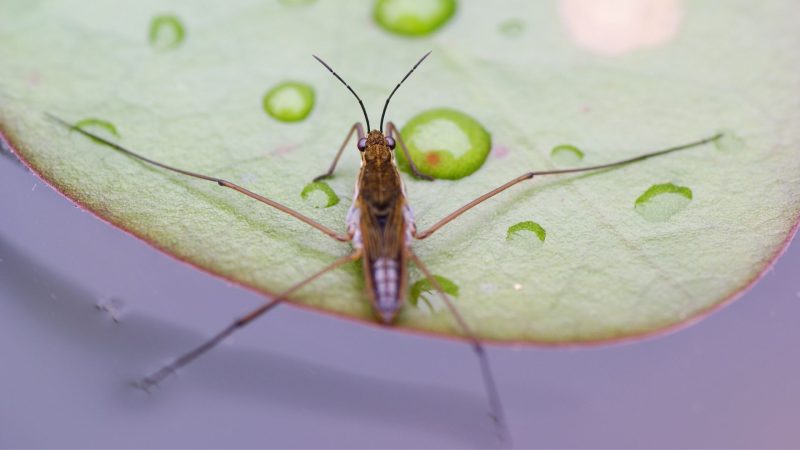
Water striders are small aquatic insects that belong to the Gerridae in the order Hemiptera. They have several other names such as water bugs, water spiders, water skeeters, water skippers, water scooters, pond skaters, and Jesus bugs. These true bugs are called such names simply because they can walk on water.
Interestingly, water striders can also dive underwater and breathe using air that is trapped in the hair on their bodies.
After diving to avoid predators, these Jesus bugs can swim upwards at a very impressive speed of 3 feet per second. Most water striders can fly, which is why they can land on ponds and swimming pools.
What Do Water Striders Look Like?
Water striders are 3/16 to 3/4 in (4.7 to 19 mm) long, with dark brown or black, flat bodies, and six slender legs. Their front legs are very short, while the middle and hind legs are very long. Both pairs of legs have hair and anteapical claws that curve at the end, making them one of the best water bug skaters.
How Can Water Striders Walk on Water Without Sinking?
Water striders can walk on water due to several factors. The hydrophobic (water-repellent) hairs on their four pairs of legs can capture small bubbles of air, which allow them to float on water.
Their thin but strong legs are evenly spread over a very large surface area, giving them the ability to walk on water without sinking.
What Do Water Striders Eat?
Water striders eat live or dead insects and larvae, including dragonflies and mosquitoes. These predatory bugs grab and hold their prey that get close to the water surface using their two front legs and suck their juices.
They can also eat small dead animals on water surfaces and algae growing in a swimming pool.
Are Water Striders Harmful to Humans?
Water striders are not harmful to humans because they don’t bite or sting. These pool bugs also don’t carry infectious diseases and don’t damage properties. Therefore, they are not dangerous. And because Jesus bugs are predators of mosquitoes, they are considered beneficial insects, not pests.
2. Water Boatman
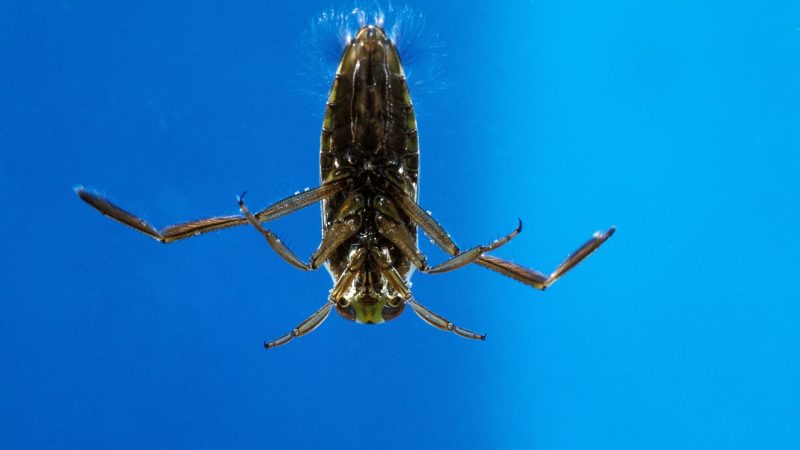
Water boatmen are true aquatic bugs that belong to the family Corixidae and are also in the order Hemiptera. They are usually mistaken for backswimmers because they have similar shapes.
Both of them also can swim and dive underwater, but they have lots of differences, including behaviors and habitat.
Just like backswimmers, water boatmen can produce a very loud sound under the water through a process called stridulation. A male water boatman will rub his penis against its abdomen to attract mates.
A study suggested that the sound can reach up to 99.2 decibels, making the water boatman the world’s loudest animal!
What Do Water Boatmen Look Like?
Water boatmen have oval, flat, and elongated bodies and are about 3/16 to 3/8 in (4.7 to 9.5 mm) long. The water boatmen have six legs, but the two pairs of hind legs look like boat oars, hence their name.
Meanwhile, their forelegs also have thin hairs and look like a scoop but are much shorter than their hind legs.
The back of the water boatmen is dark brown and has narrow, parallel crosslines, while their belly is light in color. Like other aquatic animals, this coloring protects them from predators from above because they are seen as a dark surface. On the other hand, predators below them will see them only as a sky reflection.
What Do Water Boatmen Eat?
Water boatmen eat algae, diatoms, nematodes, protozoa, and small insects such as midges and mosquito larvae. To search for food, they swim with their head down at the bottom of the water, which is why they are also sometimes called collector-gatherers. They use their tube-like mouthparts to suck juices from their prey.
Are Water Boatmen Harmful to Humans?
Water boatmen are not harmful to people since they don’t bite or sting. Their mouthparts are not capable of biting human skin. They are also clumsy once they are out of water.
These non-predaceous aquatic bugs also don’t carry diseases and, therefore, are not dangerous. Therefore, they are considered beneficial in pools.
3. Water Mites
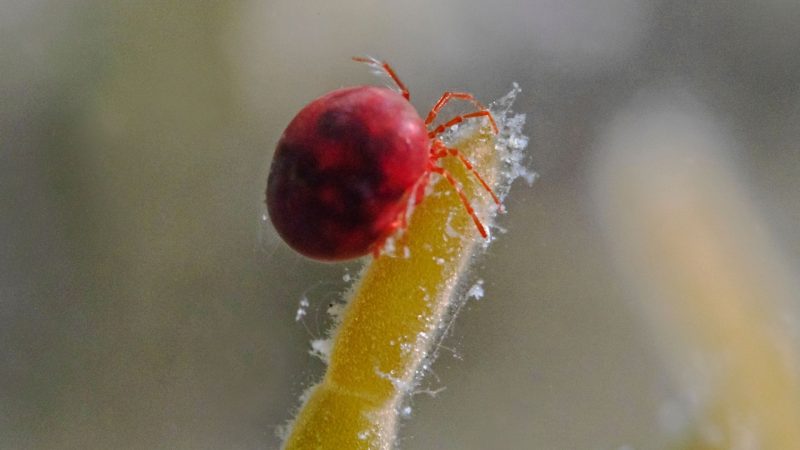
Relying on pool mites pictures can only be confusing because there are several types of pool mites, but the most common is the water mite. Scientifically known as Hydrachnidia, water mites are aquatic insects that are in the order Trombidiformes. They are closely related to scorpions, spiders, and ticks.
Most water mite species live in freshwaters such as lakes, ponds, and even swimming pools. Their larvae attach themselves to nymphs of dragonflies, mosquitoes, stoneflies, and other aquatic insects such as water boatmen until they grow into adults. In short, these insects help spread water mites.
What Do Water Mites Look Like?
Water mites look like spiders since most species have eight legs. However, their head, thorax, and abdomen are fused instead of being segmented.
They have red, flat, round bodies that are about 2-3 mm in diameter and two eyes that are very close to each other. Some species have a third eye.
Water mites that live in stagnant and quiet water have hair on their legs to swim in larger surface areas. On the other hand, the legs of those residing in running water have very tough claws to resist the strong current. Once you see them in your swimming pool, they seem to be walking on water.
What Do Water Mites Eat?
Generally speaking, water mite larvae eat aquatic microorganisms (zooplankton) and insect larvae. They live and grow in their hosts and gradually damage their health.
But while most of them are parasitic, some species also eat plants or detritus. Meanwhile, adults use their mouthparts to grab and suck their juices.
Are Water Mites Harmful to Humans?
Water mites are not harmful to people since they don’t suck human blood. They are parasites but only to their food sources, and they don’t carry infectious diseases. Aside from that, water mite larvae are not commonly exposed to humans since they live in their hosts. Likewise, adults are also not dangerous.
Swimming Pool Bugs That Bite
1. Backswimmer
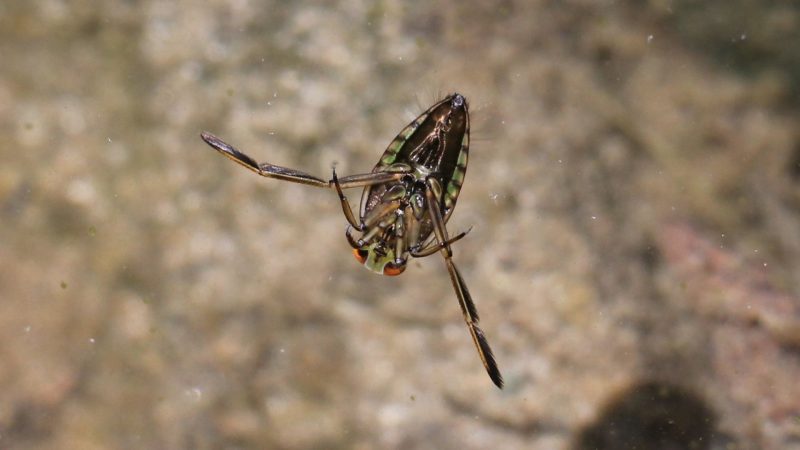
Backswimmers belong to the family Notonectidae. Scientifically known as Notonecta glauca, a common backswimmer swims upside-down through the water, making it unique among other pool bugs. They can also make sounds but not as loud as water boatmen do to attract mates underwater.
Also called greater water boatmen, backswimmers are strong fliers. However, they must first climb out of the water and turn their body over before they can fly.
As adults, these aquatic bugs hide in vegetation and usually stay on the edge of aquatic plants. However, they can also be found in ponds and swimming pools.
What Do Backswimmers Look Like?
Backswimmers are much larger than water boatmen. They are dark red, about 16 mm long, with large eyes, and a triangular body, making them look more like a boat than water boatmen.
These soft-bodied bugs have a cross-section from front to back and a keel-like top, which helps them swim fast on their backs.
Unlike water boatmen that have their beaks fused on their heads, backswimmers have a four-segmented beak. Just like water boatmen, they have three pairs of slender legs.
Their forelegs are also much shorter than their four hind legs. They also have piercing mouthparts that they use to suck body fluids from their prey.
What Do Backswimmers Eat?
Backswimmers in pools feed on various aquatic organisms like water fleas. These ambush predators also eat mosquito larvae and small vertebrate animals such as tadpoles and tiny fishes.
They use their front legs to catch their prey and hold them with their middle legs, making their unsuspecting prey harder to escape.
Are Backswimmers Harmful to Humans?
Backswimmers can be harmful to humans, but only if they are mishandled. Although not dangerous, a backswimmer bite is painful and can result in a burning sensation to the skin. The pain can be compared to a bee sting, which is why backswimmers also earned water wasp and water bee names.
2. Giant Water Bug
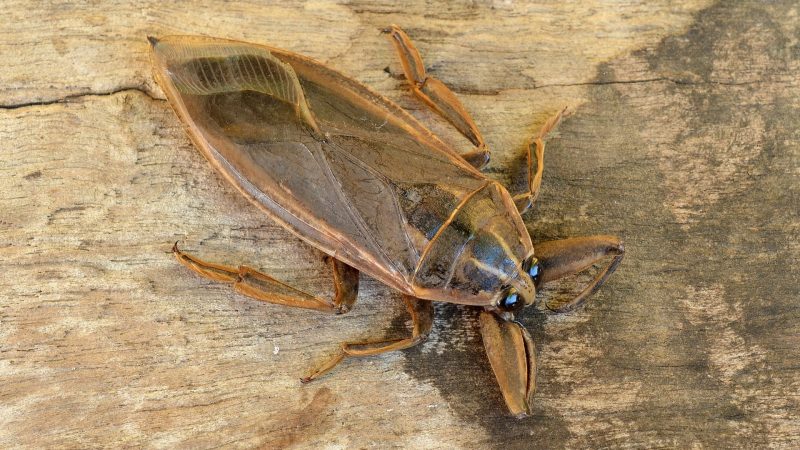
Giant water bugs are freshwater insects in the order Hemiptera. These largest true bugs are either in the Belostoma genus or Lethocerus genus. They are commonly found in lakes, ponds, shallow waters with lots of vegetation, streams, swimming pools, and other stagnant or slow-moving bodies of water.
Also called electric light bugs, giant water bugs are very much attracted to lights at night. Therefore, they can also be seen in docks and parking lots with bright lights.
Surprisingly, females don’t rear the young. Instead, Lethocerus males guard the eggs until they hatch, and Belostoma males carry the eggs on their backs.
What Do Giant Water Bugs Look Like?
As the name implies, giant water bugs are very large, and they are about 2 ½ inches long. In fact, the Lethocerus Maximus landed in the Guinness World Records as the world’s largest aquatic insect, with a length of 11.5 cm (4.53 in). However, a few species can only grow up to an inch long.
Giant water bugs are brown, with flat and elongated bodies that are pointed at both ends. These gigantic bugs also have a short beak and raptorial front legs for grabbing their prey. Their second and third pairs of flat legs are adapted for swimming. They also have two abdominal appendages that they use for breathing underwater.
What Do Giant Water Bugs Eat?
Giant water bugs eat crickets, fish, small snakes, small frogs, tadpoles, and small turtles. These ambush predators also eat their fellow aquatic insects and hairy ducklings. These powerful flyers grab their unsuspecting prey, inject poisonous enzymes that paralyze them, and suck their body fluids and digestive juices.
Are Giant Water Bugs Harmful to Humans?
Nicknamed toe-biter, giant water bugs will bite humans if handled incorrectly. A giant water bug bite can be a bit painful. Fortunately, these pool bugs don’t carry diseases and are not harmful. Giant water bugs should not be confused with Oriental cockroaches (Blatta orientalis), which are also referred to as water bugs.
3. Predaceous Diving Beetle
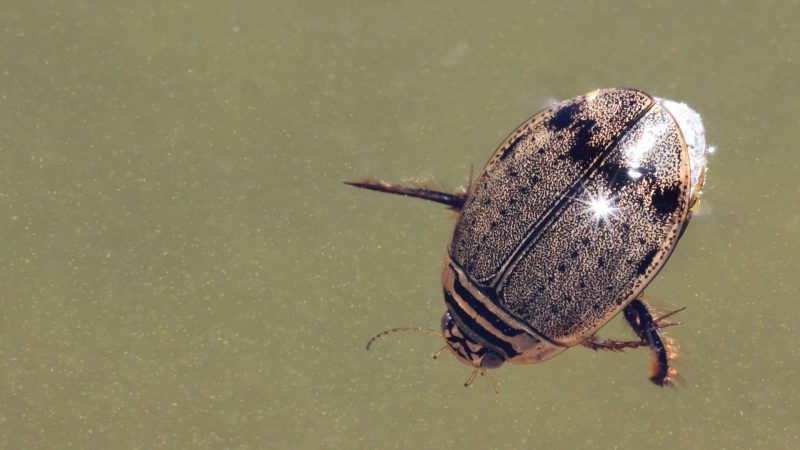
Predaceous diving beetles are aquatic beetles that belong to the family Dytiscidae, which means “able to dive” in Greek.
Being the largest family of aquatic beetles, there are around 4,300 predaceous diving beetle species around the world except for Antarctica, and about 500 of them can be found in North America.
Being fast swimmers, these water beetles are mostly found in lakes, ponds, streams, birdbaths, and swimming pools.
Before diving into the water, they catch air between their wings and body, making them able to be submerged for at least 10 minutes. They also have been known to stay underwater for 36 hours!
What Do Predaceous Diving Beetles Look Like?
Predaceous diving beetles vary in color and size, depending on the species. They can be gold, red, black, brown, or dark green, but some species can have lighter colors.
Adults can grow up to 1 1/2 inches long or more, with a smooth, oval, and streamlined body, large eyes, threadlike antennae, and six powerful legs.
Adult predaceous diving beetles kick their oar-like back legs simultaneously when swimming under the water. Interestingly, these adults also have wings but are quite clumsy flyers.
On the other hand, their larvae (also called water tigers) are two inches long. They can also swim and draw air through their spiracles.
What Do Predaceous Diving Beetles Eat?
As the name implies, predaceous diving beetles are predators and have gruesome eating habits. Adults and larvae eat small fish, snails, tadpoles, and usually attack prey larger than them.
These carnivorous aquatic beetles use their sharp jaws to inject enzymes into their prey and then ingest their body fluids.
Are Predaceous Diving Beetles Harmful to Humans?
Predaceous diving beetles are not considered harmful, but they may bite humans when not handled with care. They don’t carry diseases or inject poison to people, and their bites are quite painful but tolerable.
And because these aquatic beetles eat fish and some aquatic pest insects, they can be both beneficial and pests.
How to Get Rid of Swimming Pool Bugs Naturally?
As you probably know by now, most swimming bugs in the pool are not pests but can be nuisances. Their presence can make pools look less attractive and dirty.
But instead of killing them, it’s better if you simply remove their sources of food. To get rid of swimming pool bugs, here are some simple things you can do:
- If there are only a few pool bugs, dissolve soap into the water and spray the mixture directly on them. This prevents them from getting into the water.
- Secondly, if there are lots of pool bugs, remove them using a pool net such as POOLWHALE Professional Heavy Duty Swimming Pool Leaf Skimmer Net . You may also use this to scoop their prey, insects, and other debris in your pool.
- For severe pool bug infestations, remove algae at the sides and bottom of your pool using a pool brush such as . This product has fine bristles that won’t easily fall off.
- Vacuum your swimming pool manually. This means that you will need a pool filter pump, a vacuum hose, and a highly-dependable vacuum head such as .
- Make sure that the pH level of your swimming pool is between 7.3 and 7.6. A higher pH level means the water has too much alkaline, reducing the chlorine’s effectiveness and causing algae growth. Test the pH level and chlorine regularly using a credible 2-way test kit such as WWD POOL Swimming Pool Spa Water Chemical Test Kit . Results are more accurate than using test strips.
- Shock your swimming pool. It means adding chlorine to kill algae and bacteria and remove contaminants from the water. Shocking the pool is usually done in the evening, and the pool pump should be running. Use a trusted shock treatment such as HTH Super Shock Treatment Swimming Pool Chlorine Cleaner .
- To discourage other insects from getting near the water, trim tree branches near the pool and remove any smaller plants nearby.
- Pool bugs and insects are attracted to bright lights, which will cause them to fall into your pool. Replace them with low-wattage light bulbs.
- When your swimming pool is not in use, cover it using a durable, safe pool cover such as Blue Wave Rectangular In Ground Pool Safety Cover .
Summary
In general, swimming pool bugs are harmless, even though some of them bite humans. Don’t panic once you see them in the water. So far, the best way to prevent swimming bugs is proper maintenance of pools. If you will use public pools, take a shower before getting in and avoid swallowing pool water.
Related: How to Get Rid of Water Bugs in Your Pool? | Control and Prevention
List of Sources
Field Guide to Common Texas Insects – Insect Orders: Water Striders. Texas A&M University.
Home and Garden IPM from Cooperative Extension: Water Striders. University of Maine.
Water Boatmen, Backswimmers (2009). University of Wisconsin-Milwaukee.
Bateman, C., Hulcr, J. (2019). Predaceous Diving Beetles as Pets and the Self-Cleaning Aquarium. University of Florida.
Predaceous Diving Beetles (Water Tigers). Missouri Department of Conservation.
- How to Get Rid of Copperheads | Practical Guide - August 27, 2023
- How to Get Rid of Corn Snakes | What Makes Them Aggressive? - August 27, 2023
- How to Get Rid of Alligators | Safety Measures and Removal Methods - July 16, 2023

